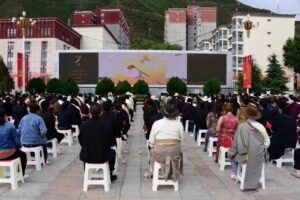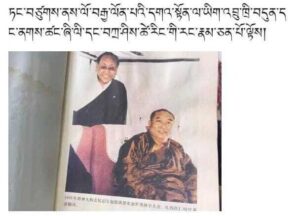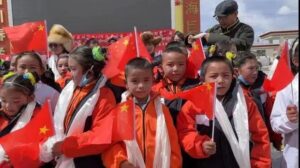Source: Tibet Watch
July 8, 2021

Tibetans in Chamdo, central Tibet, at a mandatory televised event on CCP’s centennary
History propaganda enhanced through video games and augmented reality TV series
Celebration of the Chinese Communist Party’s 100th anniversary continues both in mass media and public spaces. The party history campaign aims to cement the CCP’s version of its own history and promote a narrative of success in the public imagination.
The CCP emphasised its legitimacy and importance at a huge event on 1 July, in which officials, including CCP Chairman Xi Jinping, issued a clear warning to the western democracies against “bullying” China. In recent years, several western governments have formed alliances and jointly stood in solidarity in calling out for freedom and justice for oppressed peoples in China, especially Uyghurs.
In spite of the state media publishing images and videos of Tibetans participating in the celebrations, the reality is that of fear and coercion in which planned top-down decisions dictate the thoughts and movements of Tibetans. Abstaining from the choreographed events, expressing slightest refusal of the glorified occasion comes at the cost of being disappeared, arbitrarily detained, and tortured- a knowledge too well known amongst Tibetans in Tibet and documented by Tibet Watch and other rights groups. Released political prisoners, dedicated teachers, and public intellectuals were arrested in Serthar County in the lead-up to the CCP’s 100th in the last few months.
Mandatory attendance and celebration ordered

10th Panchen Lama and his translator Tashi Tsering, 1988, Kathmandu, Nepal, at World Religions Conference
Behind the facade of state media coverage of the forced celebrations are Tibetans who have learned, over the seventy years of occupation, how values integral to their identity are being increasingly viewed as pre-emptive threats to the stability of the CCP leadership. In the seven decades, Tibetans’ desire for freedom, the right to demand rights, were eroded slowly through non-inclusive and repressive policies. Physical and digital search operations have become a routine for Tibetans in Tibet, especially photos of their exiled spiritual leader, the 14th Dalai Lama, which is a national security crime. Those with contacts with their exiled family members are heavily monitored and silenced into self-censorship.
Inspite of such a climate of surveillance and fear, Tibetans in Tibet have still shown creative forms of expression that indicate their unbreakable connection to their own history and identity. In one such example, a Tibetan said, “In celebration of 100th anniversary of CCP, one must read 70,000 Character Petition and autobiographies of Nagtsang Nulo and Tashi Tsering.” In recommending these reading materials on the CCP’s centenary, the author of the post clearly proves the continuity and significance of Tibetan memories and history. ( Further context provided at the bottom of the page)
Sources reported that schools and monasteries in different places in Tibet including Ngaba, the epicentre of self-immolations in eastern Tibet, were ordered by the local Chinese authorities and instructed to attend and watch the televised celebration of the event and Xi Jinping’s speech. Similarly, in Lhasa, all the shops and restaurants were shut down under the same instructions to watch the event.
The Chinese state media’s stories of Tibetans attending these significant political events, its ritualistic insistence of Tibetans being happy, especially since its brutal occupation in the 1950s, forced display of allegiance by raising the Chinese national flags in Tibet, stand as vivid proof of the sheer intolerance of the CCP against any counter-narratives of histories, of identities of its diverse oppressed peoples, many of whose languages still loom largely unrecognised in its deeply discriminatory constitution.
Grassroots recruitment and training
The party functionary has instructed all the Tibetans to adhere to Xi Jinping’s speech and uphold the CCP as the highest authority. The continuity of the CCP was hailed as a success and its maintenance was emphasised. Since the 2008 Tibetan uprising, permanent party cadres were dispatched in Tibetan monasteries and rural villages of central Tibet to grow the party’s surveillance and presence as part of “stability maintenance policy”.
On 30 June, state media in the eastern Tibetan region of Amdo (Ch: Qinghai), announced the completion of in-depth three-year-long centralised training for up to around 256,400 party members including Tibetan farmers and nomads. Tibetans from grassroots communities are used to perform a dual role of implementing the top-down regulations and in doing so construct an image of a role model for younger generations. Their duties are also linked with objectives of “poverty alleviation”, “high-quality development” and disaster relief. In the same news report, 145,000 party cadres are said to have been paired up with 159,000 households of low-income.
The Organisation Department of the Provincial Party Committee selected 26,000 ”vanguard party members” from party members who are farmers or nomads in Qinghai Province. They have been taught and required to implement what the state believes as being Xi Jinping’s new era of socialism with Chinese characteristics and the “spirit” of the 19th National Congress of the Communist Party of China. Through recruitments of grass-roots farming and pastoral communities, the intimate lives of once-rural communities are ever closer to the authorities.
In Qinghai Province, publications await such as ”the curriculum system and syllabus for learning and implementing Xi Jinping’s new era of socialism with Chinese characteristics in Qinghai Province”, ”The Provincial Party Education and Training Outline” and ”Party Member Education Information Construction Project”. All party members in Qinghai have been asked to consciously become firm believers and loyal practitioners of Xi Jinping’s thoughts on socialism with Chinese characteristics in the new era.
Rewriting Tibetan history and identity

Tibetan Children in Ngari carrying Chinese national flag at a school event on 1 July
The centenary celebrations of the CCP happened against the culmination of reports of Tibetan language becoming eviscerated from schools under “bilingual policy” and Party Secretary Wu Yingjie’s statement in November 2020, regarding the importance of “instilling the red gene” from infancy in Tibet and the need to “strengthen the ideological and political education work for the younger generation to love Party, the motherland and socialism, and develop the Mandarin language as the national language from their childhood.”
Surveillance of knowledge about history is becoming equally enhanced with the use of technology. In a hit TV series called Choice, augmented reality meets party history and dead revolutionary figures are resurrected in holograms to talk about their choices. Elsewhere in the gaming world, in a game called Guilty Gear Strive, specific mentions of Uyghur, Tibet, Southern Mongolia, Mongolia, and Siberia have been removed from the official backstory without notice updates and bundled into “nearby regions.”
Note: History, as remembered by Tibetans, is crucial in understanding Tibet. Recommended readings in the social media post “In celebration of 100th anniversary of CCP, one must read 70,000 Character Petition and autobiographies of Nagtsang Nulo and Tashi Tsering” are few significant books, amongst many others, written by Tibetans which offer illuminating stories of Tibetan from various backgrounds before and after the occupation of Tibet.
70,000 Character Petition stands as one of the most detailed and significant historical documents revealing the abusive policies of the Chinese government in the aftermath of Tibet’s occupation. Originally written in Tibetan and submitted to the Chinese government in 1962, 70,000 refers to the word count of the document in its Chinese translation. Chairman Mao Zeodong, on reading the report said it was, “poisoned arrow shot at the Party by reactionary feudal lords.” The Tenth Panchen Lama was later forced to denounce the 14th Dalai Lama and heavily punished with “struggle sessions”, house arrest, and imprisonment.
Nagtsang Shilu Kyidug, The Joys and Sorrows of the Nagtsang boy, by Nagtsang Nulo, published in English as A Tibetan Childhood: When Ice Shattered Stone, offers a vivid first-hand account of the human costs of China’s nation-building in the eastern Tibetan grasslands of Amdo in the 1950s. With riveting observations of life and livelihood, this memoir recounts the process of tragic changes and torture during the arrival of the People’s Liberation Army.
Tibet is my home, by Tashi Tsering, is published in English as The Struggle for Modern Tibet. It takes the reader through the author’s pursuit of knowledge and justice. From being a young boy in the Dalai Lama’s dance troupe to his studies in the United States, Tashi Tsering recounts the unexpected challenges he undergoes in gaining trust from the ruling Chinese government throughout his commitment and service to preserve Tibetan identity and heritage.




 Print
Print Email
Email